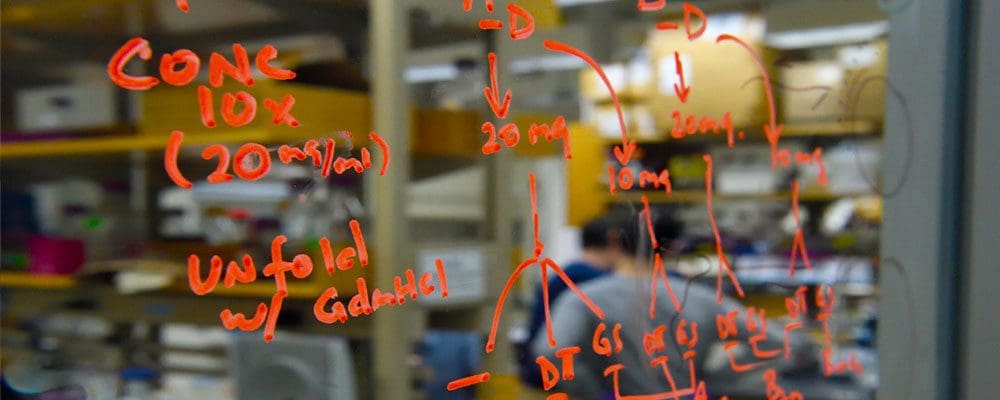There are several instrumentation specialists who supervise and/or operate the departmental instruments:
- Dr. Jonathan Catazaro (Remsen B24, NMR spectrometers and miscellaneous instruments)
- Dr. Maxime Siegler (NCB 240, X-ray diffraction)
- Dr. Phil Mortimer (Remsen B13; mass spectrometry).
Prospective users should contact them for instructions and/or to be added to the list of authorized users.
The Departmental Instrumentation Facility houses the following pieces of major instrumentation:
- Bruker Avance 400 MHz FT-NMR spectrometers (2), one located in the Instrumentation Facility in Remsen Hall and the other on the first floor of the New Chemistry Building.
- Bruker Avance 300 MHz FT-NMR spectrometer.
- Bruker Avance III 400 MHz FT-NMR spectrometer and Fourier 300 FT-NMR spectrometer with an automatic sample changer are located in the undergraduate teaching laboratory.
- Bruker Neo 500MHz Solid State NMR Spectrometer
- VG70S magnetic sector mass spectrometer, with EI, and CI ionization.
- VG70SE magnetic sector mass spectrometer, with FAB ionization.
- Finnigan LCQ Fleet ion trap Mass Spectrometer with ESI ionization and HPLC inlet.
- Waters Acquity / Xevo G2 UPLC-Q-ToF MS with ESI and APCI ionisation.
- Waters XevoG2-S – Standalone ESI mass spectrometer (can be equipped with ASAP)
- Thermo QEHF-X Orbitrap Mass Spectrometer with Ultimate 3000 NanoLC
- Bruker EMX EPR spectrometer equipped with a liquid helium cryostat and variable temperature controller.
- Jasco P-1010 polarimeter.
- SuperNova X-ray diffractometer (dual hi-flux micro-focus Mo and Cu sources) with Atlas CCD area detector (located on the second floor of the new chemistry building).
- Shimadzu QP2010SE GC-MS.
- Bruker AutoFlex Max Maldi Tof.
- Rigaku XtaLAB Synergy R equipped with a rotating-anode X-ray source (Cu Kα radiation) and HyPix-6000HE detector (located on the second floor of the new chemistry building).
Three departmental staff members are responsible for the maintenance and operation of these instruments.
NMR Facility
The NMR facility based in Remsen Hall consists of the three walk-up NMR (two in Remsen, one in the New Chemistry Building), an EPR and FTIR spectrometers, as well as a Polarimeter. In 2013, two new NMR spectrometers were purchased as part of the new Undergraduate Teaching Laboratories: a Bruker Avance III 400 MHz FT-NMR spectrometer and a Fourier 300 FT-NMR spectrometer with an automatic sample changer that can hold up to 60 samples. These can be used for research during the summer months when undergraduate labs are not in session. Upon checkout by the NMR facility manager, students are allowed to operate these instruments.
NMR spectrometers suitable for studies of biological macromolecules are located in the Biomolecular NMR Center, located in an underground facility in front of the New Chemistry Building. This center is a joint initiative of the departments of biology, biophysics, chemistry, and materials science, with additional collaboration from the School of Medicine’s departments of biochemistry and pharmacology. The instruments include 500, 600, and 800 MHz FT-NMR spectrometers. Scheduling for these spectrometers is handled by the center.
Mass Spectrometry Facility
A variety of different mass spectral techniques are available in the Mass Spectrometry Facility. High-resolution mass spectra of submitted samples are obtained on a service basis by a staff member using a magnetic sector instrument equipped with EI, CI, and FAB ionization methods. MALDI-TOF, GC/MS, and electrospray instruments are also available and operated by students and researchers following training by the facility staff.
X-ray Crystallography Facility
The X-ray Crystallography Facility is operated by a staff member. The facility is mainly concerned with the X-ray structure determinations of small molecules of new organic, inorganic, organometallic, and coordination compounds. Additionally, our dual-source Supernova diffractometer can perform crystal screening and collect data for protein crystals, and can collect high-quality data for tiny crystals.
Physical Sciences Machine Shop
The department shares the use of the Physical Sciences Machine Shop, located in Bloomberg Hall, with the Department of Physics and Astronomy. Electronics construction and repair is handled by a staff member in the Departmental Instrumentation Facility.
A department computer lab with Macintosh and Windows PC computers is available for undergraduate and graduate students to use.
In addition to the departmental instrumentation, individual research groups have acquired or constructed numerous pieces of specialized research instrumentation. A wide variety of laser systems, including Ar ion, Nd:YAG, excimer, dye lasers, and optical parametric oscillators are operational in individual faculty laboratories. Custom-built apparatuses include negative ion photoelectron spectrometers, UV and IR cavity ring-down spectrometers, electron energy-loss spectrometers, time-of-flight and magnetic mass spectrometers, molecular beam apparatus, UHV surface analysis apparatus, atomic-force microscopes, nanophase material generators, and a nanosecond time-resolved IR spectrometer.
PARADIM
The crystal growth facility of the Platform for the Accelerated Realization, Analysis, and Discovery of Interface Materials is located in Bloomberg Hall at Johns Hopkins University. For more information, including instructions for access, please visit the PARADIM website.
